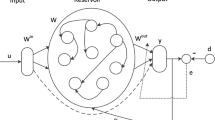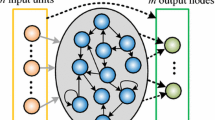Abstract
In this paper, combining the theory of numerical solution of fractional-order differential equation, a new model of discrete-time fractional-order echo state network (DFO-ESN) is proposed. In order to ensure that the DFO-ESN can be used for different learning tasks, the stability of DFO-ESN should be guaranteed. Through using an LMI approach, a sufficient stability criterion for DFO-ESN is given. According to the stability criterion, the selection range of reservoir parameters of DFO-ESN can be expanded, such that we can build the DFO-ESN without considering the initial conditions. For the candidate discrete-time Lyapunov function, it is shown that the reservoir states of DFO-ESN are asymptotically stable when time tends to infinity. Finally, two examples demonstrate the feasibility of stability criterion and the learning performance of DFO-ESN.




Similar content being viewed by others
References
Antonelo EA, Camponogara E, Foss B (2016) Echo state networks for data-driven downhole pressure estimation in gas-lift oil wells. Neural Netw 85:106–117
Bozhkov L, Koprinkova-Hristova P, Georgieva P (2016) Learning to decode human emotions with Echo State Networks. Neural Netw 78:112–119
Cottle RW (1974) Manifestations of the Schur complement. Linear Algebra Appl 8:189–211
Debnath L (2003) Recent applications of fractional calculus to science and engineering. Int J Math Math Sci 54:3413–3442
Ferreira NMF, Machado JT (2014) Mathematical methods in engineering. Springer, Berlin
Guo BL, Pu XK, Huang FH (2015) Fractional partial differential equations and their numerical solutions. World Scientific, Sinagapore
Han SI, Lee JM (2014) Fuzzy echo state neural networks and funnel dynamic surface control for prescribed performance of a nonlinear dynamic system. IEEE Trans Ind Electron 61:1099–1112
Han M, Xu ML (2018) Laplacian echo state network for multivariate time series prediction. IEEE Trans Neural Netw Learn Syst 29:238–244
Jaeger H (2002) A tutorial on training recurrent neural networks, covering BPTT, RURL, EKF and the ‘Echo State Network’ Approach. Technical Report GMD Report 159, German National Research Center for Information Technology
Jaeger H (2010) The ‘echo state’ approach to analysing and training recurrent neural networks–with an Erratum note. German National Research Center for Information Technology, GMD Report 148
Jaeger H, Haas H (2004) Harnessing nonlinearity: predicting chaotic systems and saving energy in wireless telecommunication. Science 304:78–80
Jaeger H, Lukoševičius M, Popovici D, Siewert U (2007) Optimization and applications of echo state networks with leaky-integrator neurons. Neural Netw 20:335–352
Li K, Maione G, Fei M, Gu X (2015) Recent advances on modeling, control, and optimization for complex engineering systems. Math Probl Eng 2015, ID746729
Li JD, Wu ZB, Huang NJ (2019) Asymptotical stability of Riemann-Liouville fractional-order neutral-type delayed projective neural networks. Neural Process Lett 50:565–579
Livi L, Bianchi FM, Alippi C (2018) Determination of the edge of criticality in echo state networks through fisher information maximization. IEEE Trans Neural Netw Learn Syst 29:706–717
Lun SX, Wang S, Guo TT, Du CJ (2014) An I-V model based on time warp invariant echo state network for photovoltaic array with shaded solar cells. Solar Energy 105:529–541
Malik ZK, Hussain A, Wu QJ (2017) Multilayered echo state machine: a novel architecture and algorithm. IEEE Trans Cybernet 47:946–959
Pahnehkolaei SMA, Alfi A, Machado JAT (2017a) Dynamic stability analysis of fractional order leaky integrator echo state neural networks. Commun Nonlinear Sci Numer Simul 47:328–337
Pahnehkolaei SMA, Alfi A, Machado JAT (2017b) Uniform stability of fractional order leaky integrator echo state neural network with multiple time delays. Inf Sci 418:703–716
Pahnehkolaei SMA, Alfi A, Machado JAT (2019) Delay independent robust stability analysis of delayed fractional quaternion-valued leaky integrator echo state neural networks with QUAD condition. Appl Math Comput 359:278–293
Podlubny I (1998) Fractional differential equations. Elsevier, New York
Scardapane S, Wang DH, Panella M (2016) A decentralized training algorithm for Echo State Networks in distributed big data applications. Neural Netw 78:65–74
Skowronski MD, Harris JG (2007) Automatic speech recognition using a predictive echo state network classifier. Neural Netw 20:414–423
Tong MH, Bickett AD, Christiansen EM, Cottrell GW (2007) Learning grammatical structure with echo state networks. Neural Netw 20:424–432
Wang Y, Xie L, de Souza CE (1992) Robust control of a class of uncertain nonlinear systems. Syst Control Lett 19:139–149
Wen S, Hu R, Yang Y, Huang T, Zeng Z, Song Y (2019) Memristor-based echo state network with online least mean square. IEEE Trans Syst Man Cybernet Syst 49:1787–1796
Xu CJ, Li PL (2019) On finite-time stability for fractional-order neural networks with proportional delays. Neural Process Lett 50:1241–1256
Xu S, Lu J, Zhou S (2004) Design of observers for a class of discrete-time uncertain nonlinear systems with time delay. J Frankl Inst 341:295–308
Xu M, Han M, Qiu T (2019) Hybrid regularized echo state network for multivariate chaotic time series prediction. IEEE Trans Cybernet 49:2305–2315
Yang XJ, Li CD, Huang TW, Song QK, Huang JJ (2018) Global Mittag-Leffler synchronization of fractional-order neural networks via impulsive control. Neural Process Lett 48:459–479
Yang C, Qiao J, Wang L (2019) Dynamical regularized echo state network for time series prediction. Neural Comput Appl 31:6781–6794
Zhang LZ, Yang YQ (2019) Stability analysis of fractional order Hopfield neural networks with optimal discontinuous control. Neural Process Lett 50:581–593
Zhang HG, Wang ZS, Liu DR (2014) A comprehensive review of stability analysis of continuous-time recurrent neural networks. IEEE Trans Neural Netw Learn Syst 25:1229–1262
Acknowledgements
This work was supported by the National Natural Science Foundation of China under Grant 61473070 and Grant 61627809 and in part by Fundamental Research Funds for the State Key Laboratory of Synthetical Automation for Process Industries (SAPI) under Grant 2018ZCX22 and Liaoning Revitalization Talents Program under Grant XLYC1802010.
Author information
Authors and Affiliations
Corresponding author
Ethics declarations
Conflict of interest
The authors declared that they have no conflicts of interest to this work. We declare that we do not have any commercial or associative interest that represents a conflict of interest in connection with the work submitted.
Additional information
Communicated by V. Loia.
Publisher's Note
Springer Nature remains neutral with regard to jurisdictional claims in published maps and institutional affiliations.
Rights and permissions
About this article
Cite this article
Yao, X., Wang, Z. & Huang, Z. A stability criterion for discrete-time fractional-order echo state network and its application. Soft Comput 25, 4823–4831 (2021). https://doi.org/10.1007/s00500-020-05489-0
Published:
Issue Date:
DOI: https://doi.org/10.1007/s00500-020-05489-0




